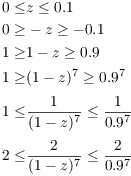Example. Expand ![]() in a power series at
in a power series at ![]() and find the interval of convergence.
and find the interval of convergence.
I will use the series for ![]() :
:
![]()
I need powers of ![]() , so I make an "
, so I make an "![]() " on the bottom, then fix the numbers so the
value of the fraction doesn't change. Then I do algebra to put my
function into the form
" on the bottom, then fix the numbers so the
value of the fraction doesn't change. Then I do algebra to put my
function into the form ![]() , at
which point I can substitute:
, at
which point I can substitute:

![]()
I substituted ![]() in the
u-series to get my series.
in the
u-series to get my series.
The interval of convergence for the series for ![]() is
is ![]() . Substitute
. Substitute
![]() :
:

Example. Find the interval of convergence of
![]() .
.
Apply the Root Test:
![]()
The series converges for
![]()
At ![]() , the series is
, the series is
![]()
This series diverges by the Zero Limit Test.
At ![]() , the series is
, the series is
![]()
This series also diverges by the Zero Limit Test.
The power series converges for ![]() and diverges elsewhere.
and diverges elsewhere.![]()
Example. Expand ![]() in a power series at
in a power series at ![]() and find the interval of convergence.
and find the interval of convergence.
![]()
Set ![]() in
in
![]()
This gives
![]()
The interval of convergence for the ![]() series is
series is ![]() . So
for the
. So
for the ![]() series,
series,
![]()
Example. Expand ![]() in a Taylor series at
in a Taylor series at ![]() .
.
Using the double angle formula
![]()
![]()
Example. (a) Use the first four nonzero terms
of the Taylor series for ![]() at
at ![]() to approximate
to approximate ![]() .
.
(b) Use the Alternating Series Test to estimate the error in part (a).
(a)
![]()
Hence,
![]()
![]()
(I used the first four terms to get the approximation.)![]()
(b) The error is no greater than the next term, which is ![]() .
.![]()
Example. Use the Taylor series expansion of
![]() at
at ![]() to explain the fact
that
to explain the fact
that ![]() .
.
The series for ![]() at
at ![]() is
is
![]()
Divide by x to obtain
![]()
Then
![]()
Example. Find the first four nonzero terms of
the Taylor expansion for ![]() at
at ![]() .
.
![]()
The series is
![]()
Example. Find the interval of convergence of
![]() .
.

![]()
The series converges for
![]()
At ![]() , the series is
, the series is
![]()
This is harmonic, so it diverges.
At ![]() , the series is
, the series is
![]()
This is harmonic, so it diverges.
The power series converges for ![]() and diverges
elsewhere.
and diverges
elsewhere.![]()
Example. ![]() satisfies
satisfies
![]()
Use the third degree Taylor polynomial for f at ![]() to approximate
to approximate ![]() .
.
The third degree Taylor polynomial for f at ![]() is
is
![]()
So
![]()
Example. Suppose that ![]() . Use
. Use ![]() to estimate the error in using the fourth degree
Taylor polynomial at
to estimate the error in using the fourth degree
Taylor polynomial at ![]() to approximate
to approximate ![]() for
for ![]() .
.
For some z between 0 and x,
![]()
Since ![]() ,
, ![]() .
.
For the z-term, I have ![]() . Thus,
. Thus,

So ![]() .
Therefore,
.
Therefore,
![]()
Copyright 2019 by Bruce Ikenaga